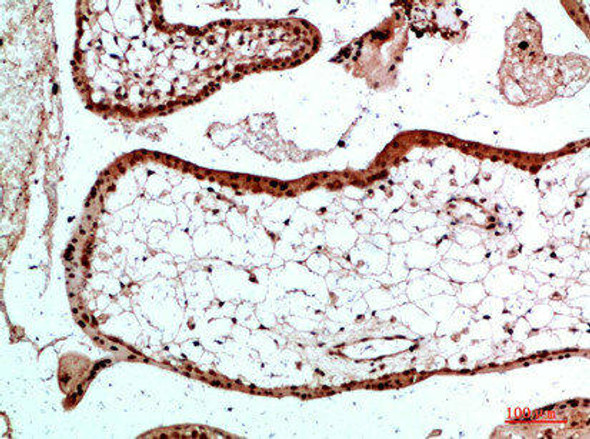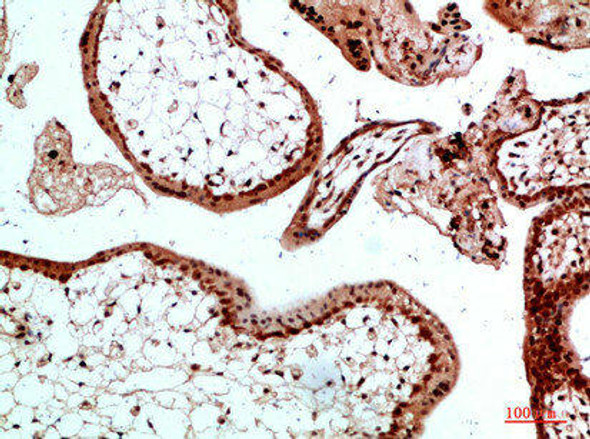Description
Acetyl-UBA52/RPS27A/UBB/UBC (K29) Antibody (PACO06079)
The Acetyl-Uba52/Rps27a/Ubb/Ubc K29 Antibody (PACO06079) is a highly specific and sensitive polyclonal antibody designed for research involving the acetylation of Uba52, Rps27a, Ubb, and Ubc at lysine 29. This antibody, raised in rabbits, is validated for use in various applications, including Western blot and immunohistochemistry.Acetylation is a critical post-translational modification that regulates the activity and function of proteins involved in diverse cellular processes. The acetylation of Uba52, Rps27a, Ubb, and Ubc at lysine 29 has been implicated in the regulation of protein degradation, DNA repair, and cell cycle progression. This antibody specifically recognizes the acetylated forms of these proteins, allowing for the detection and analysis of their acetylation status in different cell types and tissues.
Research into the acetylation of Uba52, Rps27a, Ubb, and Ubc at lysine 29 is essential for understanding their roles in cellular pathways and disease processes. Dysregulation of protein acetylation has been associated with various diseases, including cancer, neurodegenerative disorders, and metabolic syndromes. By studying the acetylation of these proteins, researchers can gain insights into potential therapeutic targets for these diseases and develop novel treatment strategies.Overall, the Acetyl-Uba52/Rps27a/Ubb
| Antibody Name: | Acetyl-UBA52/RPS27A/UBB/UBC (K29) Antibody (PACO06079) |
| Antibody SKU: | PACO06079 |
| Size: | 50ug |
| Host Species: | Rabbit |
| Tested Applications: | ELISA, WB |
| Recommended Dilutions: | ELISA:1:20000, WB:1:500-1:2000 |
| Species Reactivity: | Human, Mouse, Rat |
| Immunogen: | Synthesized peptide derived from the human Ub around the acetylation site of K29. |
| Form: | Liquid |
| Storage Buffer: | Liquid in PBS containing 50% glycerol, 0.5% BSA and 0.02% sodium azide. |
| Purification Method: | The antibody was affinity-purified from rabbit antiserum by affinity-chromatography using epitope-specific immunogen. |
| Clonality: | Polyclonal |
| Isotype: | IgG |
| Conjugate: | Non-conjugated |
 | Western Blot analysis of HepG2 cells using Acetyl-Ub (K29) Polyclonal Antibody. |
 | Western Blot analysis of HepG2 cells using Acetyl-Ub (K29) Polyclonal Antibody. |
| Synonyms: | UBB; Polyubiquitin-B; UBC; Polyubiquitin-C; RPS27A; UBA80; UBCEP1; Ubiquitin-40S ribosomal protein S27a; Ubiquitin carboxyl extension protein 80; UBA52; UBCEP2; Ubiquitin-60S ribosomal protein L40; CEP52; Ubiquitin A-52 residue ribosomal protein fusion pr |
| UniProt Protein Function: | UBA52: the gene (UBA52) that encodes this protein is one of four that encode for ubiquitin: UBC, UBB, UBA52 and RPS27A. UBB and UBC genes code for a polyubiquitin precursor with exact head to tail repeats, the number of repeats differ between species and strains. UBA52 and RPS27A genes code for a single copy of ubiquitin fused to the ribosomal proteins L40 and S27a, respectively. The RPS27A gene product is cleaved into the following 2 chains: ubiquitin (amino acids 1-76) and the 60S ribosomal protein L40 (77 ? 128). Ubiquitin is a peptide 76 amino acids in length that can be covalently attached to target lysines either as a monomer or as a lysine-linked polymer. Hundreds of ubiquitin ligases and hydrolases have been identified, implicating ubiquitin as a major regulatory element in many crucial cellular systems. It can be covalently bound to target proteins via an isopeptide bond either as a monomer (monoubiquitin), a polymer linked via different Lys residues of the ubiquitin (polyubiquitin chains) or a linear polymer linked via the initiator Met of the ubiquitin (linear polyubiquitin chains). Polyubiquitin chains, when attached to a target protein, have different functions depending on the Lys residue of the ubiquitin that is linked: Lys-6-linked may be involved in DNA repair; Lys-11-linked is involved in ERAD (endoplasmic reticulum-associated degradation) and in cell-cycle regulation; Lys-29-linked is involved in lysosomal degradation; Lys-33-linked is involved in kinase modification; Lys-48-linked is involved in protein degradation via the proteasome; Lys-63-linked is involved in endocytosis, DNA-damage responses as well as in signaling processes leading to activation of the transcription factor NF-kappa-B. Linear polymer chains formed via attachment by the initiator Met lead to cell signaling. Ubiquitin is usually conjugated to Lys residues of target proteins, however, in rare cases, conjugation to Cys or Ser residues has been observed. When polyubiquitin is free (unanchored-polyubiquitin), it also has distinct roles, such as in activation of protein kinases, and in signaling. At the protein level, it is not possible to easily determine which of the four genes encoded a given ubiquitin chain. |
| UniProt Protein Details: | Protein type:Ribosomal; Translation Chromosomal Location of Human Ortholog: 19p13.1-p12 Cellular Component: nucleoplasm; lysosomal membrane; plasma membrane; ribosome; endosome membrane; cytosol Molecular Function:protein binding; structural constituent of ribosome Biological Process: circadian rhythm; SRP-dependent cotranslational protein targeting to membrane; I-kappaB kinase/NF-kappaB cascade; negative regulation of ubiquitin-protein ligase activity during mitotic cell cycle; protein polyubiquitination; nerve growth factor receptor signaling pathway; viral reproduction; activation of MAPK activity; positive regulation of apoptosis; stress-activated MAPK cascade; toll-like receptor 3 signaling pathway; endosome transport; T cell receptor signaling pathway; DNA damage response, signal transduction by p53 class mediator resulting in cell cycle arrest; activation of NF-kappaB transcription factor; regulation of apoptosis; toll-like receptor 5 signaling pathway; antigen processing and presentation of peptide antigen via MHC class I; transforming growth factor beta receptor signaling pathway; translational initiation; JNK cascade; antigen processing and presentation of exogenous peptide antigen via MHC class I; viral transcription; G2/M transition of mitotic cell cycle; toll-like receptor 4 signaling pathway; regulation of interferon type I production; glycogen biosynthetic process; fibroblast growth factor receptor signaling pathway; positive regulation of I-kappaB kinase/NF-kappaB cascade; transcription, DNA-dependent; glucose metabolic process; antigen processing and presentation of exogenous peptide antigen via MHC class I, TAP-dependent; Notch receptor processing; virus assembly; toll-like receptor 2 signaling pathway; translational elongation; carbohydrate metabolic process; viral protein processing; mRNA catabolic process, nonsense-mediated decay; positive regulation of transcription from RNA polymerase II promoter; toll-like receptor 9 signaling pathway; negative regulation of interferon type I production; G1/S transition of mitotic cell cycle; negative regulation of apoptosis; negative regulation of epidermal growth factor receptor signaling pathway; positive regulation of ubiquitin-protein ligase activity during mitotic cell cycle; translation; apoptosis; pathogenesis; translational termination; negative regulation of transcription from RNA polymerase II promoter; viral infectious cycle; toll-like receptor 10 signaling pathway; anaphase-promoting complex-dependent proteasomal ubiquitin-dependent protein catabolic process; positive regulation of interferon type I production; transmembrane transport; epidermal growth factor receptor signaling pathway; transcription initiation from RNA polymerase II promoter; Notch signaling pathway; cytokine and chemokine mediated signaling pathway; MyD88-independent toll-like receptor signaling pathway; protein modification process; DNA repair; MyD88-dependent toll-like receptor signaling pathway; cellular protein metabolic process; regulation of ubiquitin-protein ligase activity during mitotic cell cycle; toll-like receptor signaling pathway; innate immune response; gene expression; mitotic cell cycle; negative regulation of transforming growth factor beta receptor signaling pathway |
| NCBI Summary: | Ubiquitin is a highly conserved nuclear and cytoplasmic protein that has a major role in targeting cellular proteins for degradation by the 26S proteosome. It is also involved in the maintenance of chromatin structure, the regulation of gene expression, and the stress response. Ubiquitin is synthesized as a precursor protein consisting of either polyubiquitin chains or a single ubiquitin moiety fused to an unrelated protein. This gene encodes a fusion protein consisting of ubiquitin at the N terminus and ribosomal protein L40 at the C terminus, a C-terminal extension protein (CEP). Multiple processed pseudogenes derived from this gene are present in the genome. [provided by RefSeq, Jul 2008] |
| UniProt Code: | P62987 |
| NCBI GenInfo Identifier: | 302393718 |
| NCBI Gene ID: | 7311 |
| NCBI Accession: | P62987.2 |
| UniProt Secondary Accession: | P62987,P02248, P02249, P02250, P14793, P62988, Q29120 Q6LBL4, Q6LDU5, Q8WYN8, Q91887, Q91888, |
| UniProt Related Accession: | P62987 |
| Molecular Weight: | 14,728 Da |
| NCBI Full Name: | Ubiquitin-60S ribosomal protein L40 |
| NCBI Synonym Full Names: | ubiquitin A-52 residue ribosomal protein fusion product 1 |
| NCBI Official Symbol: | UBA52 |
| NCBI Official Synonym Symbols: | L40; CEP52; RPL40; HUBCEP52 |
| NCBI Protein Information: | ubiquitin-60S ribosomal protein L40; ubiquitin-CEP52; ubiquitin-52 amino acid fusion protein; ubiquitin carboxyl extension protein 52 |
| UniProt Protein Name: | Ubiquitin-60S ribosomal protein L40 |
| UniProt Synonym Protein Names: | CEP52; Ubiquitin A-52 residue ribosomal protein fusion product 1Cleaved into the following 2 chains:Ubiquitin; 60S ribosomal protein L40 |
| Protein Family: | Ubiquitin |
| UniProt Gene Name: | UBA52 |
| UniProt Entry Name: | RL40_HUMAN |
| Secondary Antibody |
| Anti-HRP Goat Anti-Rabbit IgG (H+L) Antibody (CABS014) |
| Recommended Products |
| Anti-FITC Goat Anti-Rabbit IgG (H+L) Antibody (CABS011) |
| Anti-HRP-conjugated Beta Actin Antibody (CABC028) |

















